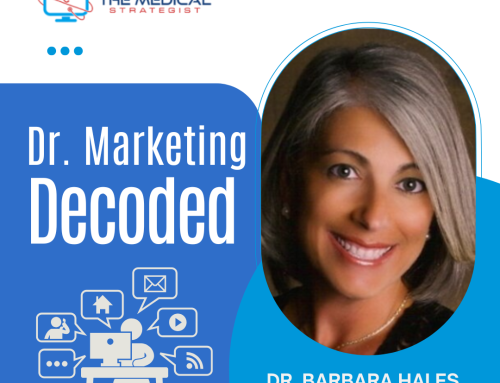Podcast: Play in new window | Download
Subscribe: RSS
In this episode, Barbara discusses:
- Why a logo is essential for your business.
- What makes a great logo?
- Exploring different ways to use your logo to build your brand.
Key Takeaways:
“Logos provide brand recognition. Having a strong image helps your business stick out in people’s minds and makes you stand out over your competition.” – Barbara Hales.
Connect with Barbara Hales:
Twitter: @DrBarbaraHales
Facebook: facebook.com/theMedicalStrategist
Business Website: www.TheMedicalStrategist.com
Email: halesgangb@aol.com
YouTube: https://www.youtube.com/TheMedicalStrategist
LinkedIn: www.linkedin.com/in/barbarahales
Books:
Content Copy Made Easy
14 Tactics to Triple Sales
Power to the Patient: The Medical Strategist
TRANSCRIPTION (141)
Dr. Barbara Hales: Welcome to another episode of Marketing Tips for Doctors! I’m your host, Dr. Barbara Hales. Today we will be discussing logos and the need for it in your practice or business.
The Power of Logos in Business
Dr. Barbara Hales: Does your business or medical practice have a logo yet? It is one of the basic foundations for brand marketing or promoting yourself and your services. Look around you. All of the companies that you buy products from or utilize their services have one. And just seeing the logo instantly helps you recognize and think of that company. Now, even hospitals and medical services have them.
The best logos have stood the test of time, are easily identifiable, and can be linked to the company. Examples of the best ones include Starbucks with the mermaid design, flowing lines, and green color. Apple with an apple and a leafy stem with a bite out of it. Nike has the checkmark or swish we’ve all seen that is internationally recognized. FedEx is the large F E D in purple and E X in orange connected to each other. Shell Gas has a red and yellow emblem of a shell that has stayed consistent. The McDonald’s logo consists of two large yellow arches. These are recognized as McDonald’s throughout the world and can be seen from blocks away. Of course, we can’t think of logos without mentioning Coke with its red script font, and GEICO Insurance with its cute talking gecko.
7 Benefits of Having a Great Logo
Dr. Barbara Hales: In case these examples haven’t convinced you, let’s break it down into seven benefits of having a great logo that truly represents you. First, you appear professional, people see the logo and perceive you to be an established business.
Logos provide brand recognition. Having a strong image helps your business stick out in people’s minds and makes you stand out from your competition.
You can infuse your personality into the logo including animals, cartoons, bright colors, and interesting designs which reflect originality. Let’s face it, everyone likes a cute animal.
Logos provide consistency. The colors and look of your logo will appear on your stationery website and social media platforms in addition to your podcast, press releases, and published books.
Logos provide loyalty as it grows in recognition. More people will know who they liked to support and will seek you out.
Logos enable you to stand out over the noise online and stand out from your competition. Since you have mere seconds to attract attention, an eye-catching logo will draw them in.
Finally, Logos play an essential part in marketing your business. Your logos can be posted in different ways, such as headers and banners to link you to your product and that it’s you that people should seek out.
Logo Building Strategies
Dr. Barbara Hales: So now that you’re convinced of the importance and having a logo, let’s chat about a logo-building strategy. Just by looking at an image, you know immediately that the first one above is Facebook, then Google Plus, LinkedIn. Do you have a logo for your practice? I ask you that again now that we’ve discussed all the benefits. Is it recognizable and easily represents what you stand for?
Prior to creating a strong logo for your business, essential ideas need to be considered so that the logo not only represents your business but also makes a lasting impact in the minds of prospective patients and clients. Keep in mind that a great logo is more than just images and words. It tells a story about your business, who you are, and the services that you provide.
While you’re not supposed to judge a book by its cover. People do that every day when they encounter a company’s logos. A company with a strong logo stands out as professional and memorable. One that you will call for that appointment when the need arises. So let’s take a look at a logo-building strategy: First, determine the function of your logo. A logo not only represents your brand but also provides these benefits.
It develops trust. A logo that conveys your honesty and integrity develops trust with prospective clients and patients, putting them at ease. It boosts recognition. A strong logo helps clients recognize your brand and educate you in front of your competition. It induces memorability. Logos are easier to remember the names and services.
Over time patients come to link your logo to your practice. And it builds admiration by creating a logo that is well-regarded for its good looks. cleverness or effective simplicity gives the perception of your professionalism and effectiveness. Consider your target market. Customize the look of your logo to appeal to those who will be using your services. Decide whether to insert your business name into the logo.
Having your name as part of your logo design may not always be a good idea. If your name is too long, too generic, or doesn’t translate well, just leave the name out. Be consistent with your business color scheme. If you have established certain colors in your website, brochures, advertising, and other materials. It’s important that those colors are reflected in the logo. This develops familiarity, you want customers to be able to mentally associate your logo with you. If no color scheme has been chosen yet, research the psychology of colors so that you can actually select one.
Don’t imitate successful logos. Imitating a logo of another company not only says that you’re uninspired, but also prevents you from standing out. Successful logos should be simple, memorable, and appropriate. Aim for this as you play with ideas. If you are struggling with ideas, try using different keywords to conduct searches online, or use a thesaurus to move your thinking in some new directions. Sketch things out and play around with them. Write keywords in different fonts. Seeing something visual sparks an idea for you.
Keep it simple. Attempting to convey too many messages with one design will sabotage the success of your logo. Avoid too many colors, multiple fronds, and layered images. A confusing or cluttered logo won’t convey a clear image. A simple logo is easier and less expensive to reproduce. Just think of the McDonald’s arches. It’s two arches in yellow, which you can see for blocks around. It has two arches, and it’s yellow. Different McDonald’s don’t have different colors or designs. It’s just one thing and one color.
Create several designs and test them, see what works and what doesn’t. Even the ones that you discard may spark an idea or offer an element that you want to retain in the next version of your design. Draw a rough sketch in the initial stages of your logo design process. Sketching is a quick and easy way to get ideas where you can evaluate them more easily. Don’t erase. Designing is not a linear process. Keep the pages with the designs that you didn’t like. They may spark an idea or upon later examination, offer something of value.
Get feedback from people in your target market. Show your designs to a sampling of people who fit the profile of your ideal client. You may show them multiple designs, or simply the one it feels to be the strongest candidate. ask key questions that will reveal their reaction to the logo. Do they think it’s boring or exciting, ugly or attractive, generic or unique? Also check to see what image or message the logo conveys to them, whether they find it easy to read or recognize, and if it seems consistent with what they know about your company or about your industry. Get specifics. If your sample says the logo is confusing or difficult to read, press them for details. The more you can find out before you invest in all of your print collateral, the easier it will be to tweak the design. Use social media. If your company has an established online presence, run your logo past those who are connected to you and listen to what they have to say.
Make sure that the design is scalable. Your logo must function well, whether it’s being reproduced in a large or a small format. Remember, people are going to be looking at their smart devices not just at desktops. Graphic design programs, such as Adobe Illustrator or Inkscape will allow you to test the scalability of your design. If you’re working by hand initially, try making copies of your design at different size settings. If a logo is drawn to look good at a business card size, it may appear clunky when reproduced larger. Select the final draft, digitalize your logo, or outsource it. Adobe Illustrator is the most popular program, but Inkscape is another offering, and it can be downloaded online for free. There are a number of instructional books and websites that can help you learn Illustrator.
To ensure your company logo attracts business, design it with a five-year-old in mind. According to Brittany Hodak, co-founder of ZinePak, a publishing company that specializes in branding content, most five-year-olds in America can recognize more than a dozen brands by their logo. It’s not just because these logos are you pick you pick you test. It’s because they’re clear, simple, and easy to remember. Scott Gerber says to pick something that’s as simple as possible. No more than two colors. Easy to remember, and works in a simple, super small format, or super large format. Think billboard before finalizing anything, show your logo to 10 strangers for five seconds, then ask them to close their eyes and draw it from memory. If they can draw something that’s close, you need something simpler.
Outsourcing Your Logo Design
Dr. Barbara Hales: If you have a great idea but feel that you can’t possibly design or draw it, there are places where you can outsource that for a relatively little price. For instance, fiverr.com enables you to hire a graphic designer for $5 and up. You discuss your ideas with them and then they come up with a design. Or you can run a contest at 99designs.com, where graphic artists go in and compete for your selection. And you just give feedback along the way as to whether they’re along the right path, or they’re on the wrong track so that the designers can get a better idea of what you’re looking for.
Now it’s time for you to get out and create that logo. Good luck! This has been Dr. Hales on Marketing Tips for Doctors. Till next time!



